(PDF) Ethical issues of human cloning
VerifiedAdded on 2021/12/05
|8
|2083
|164
AI Summary
Contribute Materials
Your contribution can guide someone’s learning journey. Share your
documents today.
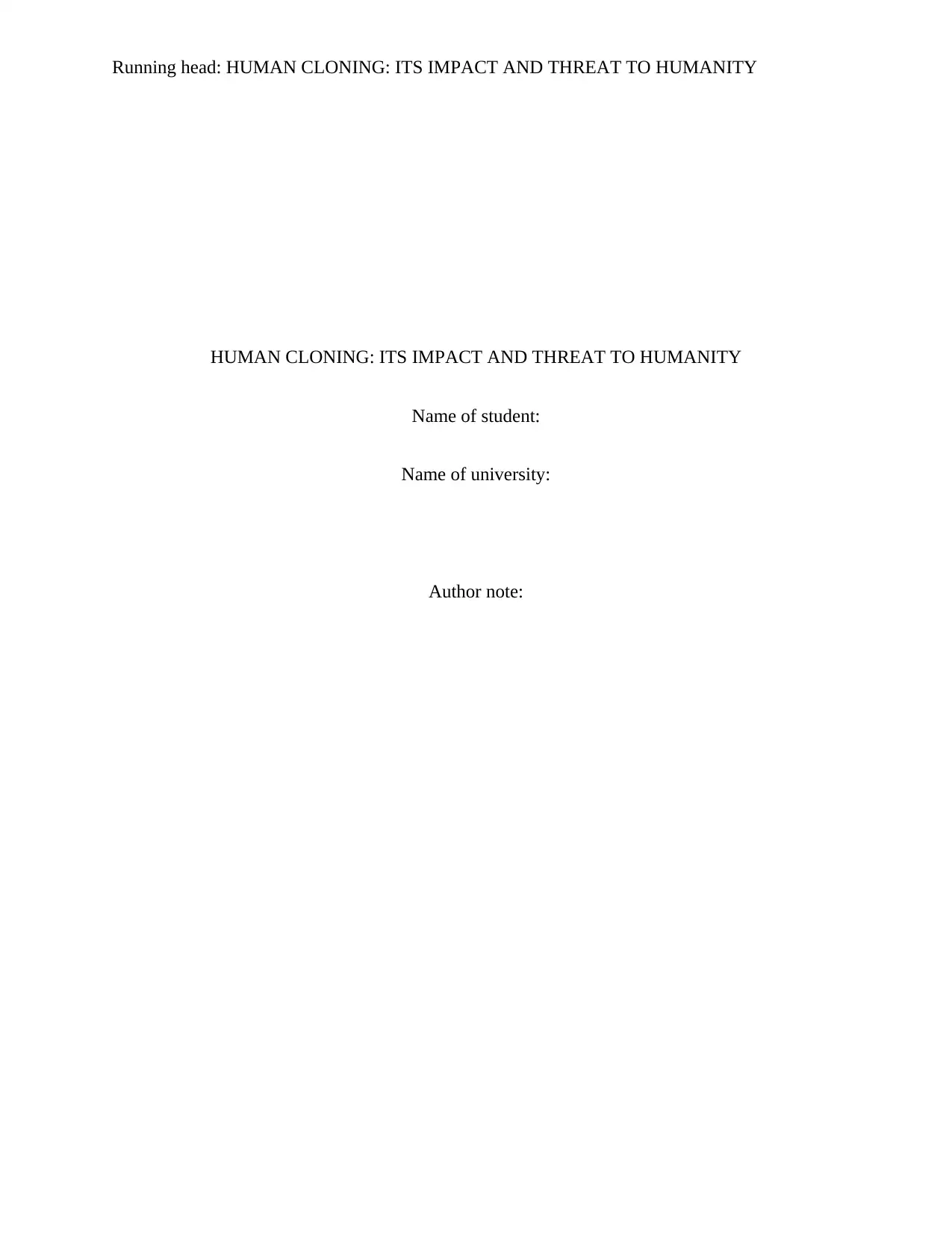
Running head: HUMAN CLONING: ITS IMPACT AND THREAT TO HUMANITY
HUMAN CLONING: ITS IMPACT AND THREAT TO HUMANITY
Name of student:
Name of university:
Author note:
HUMAN CLONING: ITS IMPACT AND THREAT TO HUMANITY
Name of student:
Name of university:
Author note:
Secure Best Marks with AI Grader
Need help grading? Try our AI Grader for instant feedback on your assignments.
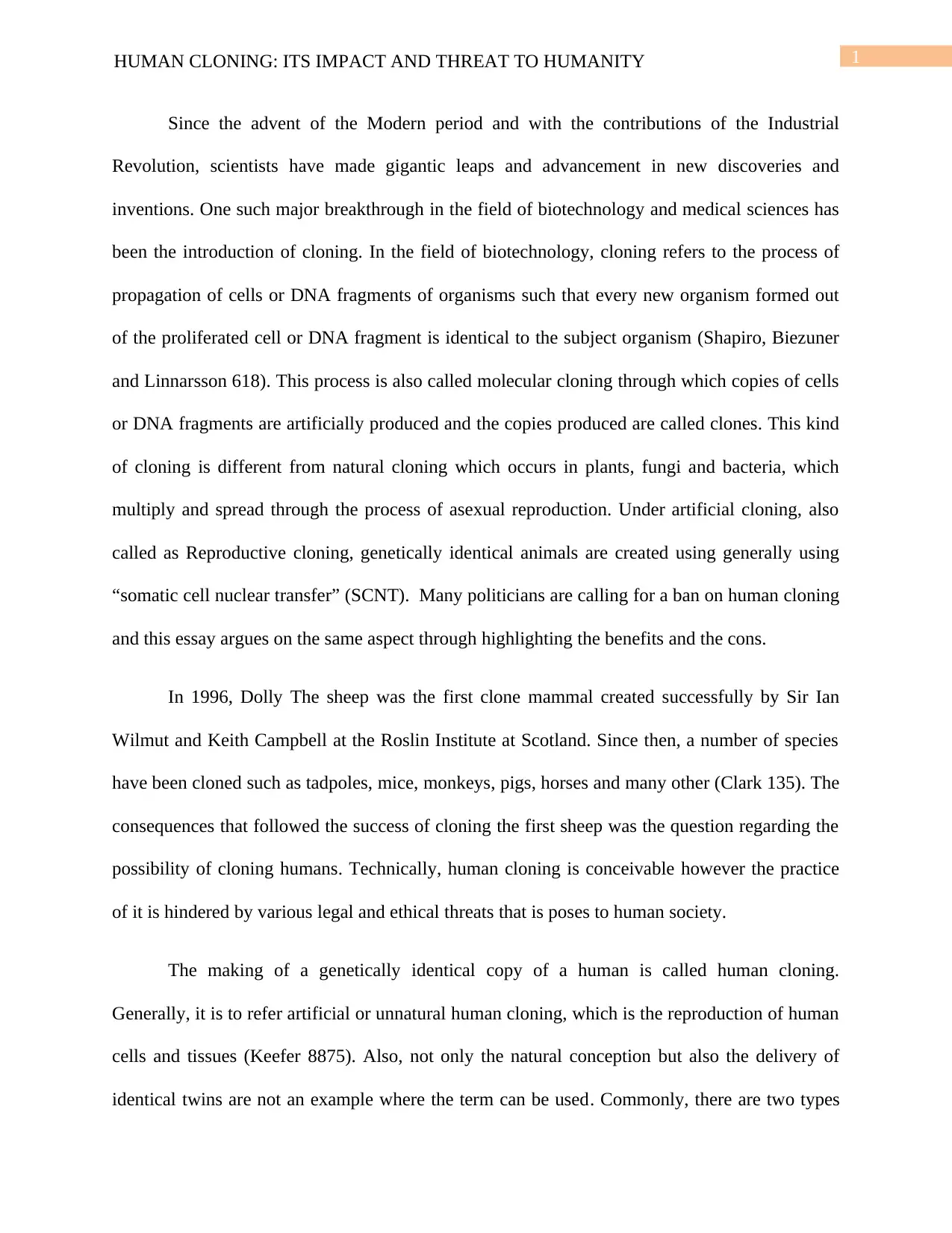
1HUMAN CLONING: ITS IMPACT AND THREAT TO HUMANITY
Since the advent of the Modern period and with the contributions of the Industrial
Revolution, scientists have made gigantic leaps and advancement in new discoveries and
inventions. One such major breakthrough in the field of biotechnology and medical sciences has
been the introduction of cloning. In the field of biotechnology, cloning refers to the process of
propagation of cells or DNA fragments of organisms such that every new organism formed out
of the proliferated cell or DNA fragment is identical to the subject organism (Shapiro, Biezuner
and Linnarsson 618). This process is also called molecular cloning through which copies of cells
or DNA fragments are artificially produced and the copies produced are called clones. This kind
of cloning is different from natural cloning which occurs in plants, fungi and bacteria, which
multiply and spread through the process of asexual reproduction. Under artificial cloning, also
called as Reproductive cloning, genetically identical animals are created using generally using
“somatic cell nuclear transfer” (SCNT). Many politicians are calling for a ban on human cloning
and this essay argues on the same aspect through highlighting the benefits and the cons.
In 1996, Dolly The sheep was the first clone mammal created successfully by Sir Ian
Wilmut and Keith Campbell at the Roslin Institute at Scotland. Since then, a number of species
have been cloned such as tadpoles, mice, monkeys, pigs, horses and many other (Clark 135). The
consequences that followed the success of cloning the first sheep was the question regarding the
possibility of cloning humans. Technically, human cloning is conceivable however the practice
of it is hindered by various legal and ethical threats that is poses to human society.
The making of a genetically identical copy of a human is called human cloning.
Generally, it is to refer artificial or unnatural human cloning, which is the reproduction of human
cells and tissues (Keefer 8875). Also, not only the natural conception but also the delivery of
identical twins are not an example where the term can be used. Commonly, there are two types
Since the advent of the Modern period and with the contributions of the Industrial
Revolution, scientists have made gigantic leaps and advancement in new discoveries and
inventions. One such major breakthrough in the field of biotechnology and medical sciences has
been the introduction of cloning. In the field of biotechnology, cloning refers to the process of
propagation of cells or DNA fragments of organisms such that every new organism formed out
of the proliferated cell or DNA fragment is identical to the subject organism (Shapiro, Biezuner
and Linnarsson 618). This process is also called molecular cloning through which copies of cells
or DNA fragments are artificially produced and the copies produced are called clones. This kind
of cloning is different from natural cloning which occurs in plants, fungi and bacteria, which
multiply and spread through the process of asexual reproduction. Under artificial cloning, also
called as Reproductive cloning, genetically identical animals are created using generally using
“somatic cell nuclear transfer” (SCNT). Many politicians are calling for a ban on human cloning
and this essay argues on the same aspect through highlighting the benefits and the cons.
In 1996, Dolly The sheep was the first clone mammal created successfully by Sir Ian
Wilmut and Keith Campbell at the Roslin Institute at Scotland. Since then, a number of species
have been cloned such as tadpoles, mice, monkeys, pigs, horses and many other (Clark 135). The
consequences that followed the success of cloning the first sheep was the question regarding the
possibility of cloning humans. Technically, human cloning is conceivable however the practice
of it is hindered by various legal and ethical threats that is poses to human society.
The making of a genetically identical copy of a human is called human cloning.
Generally, it is to refer artificial or unnatural human cloning, which is the reproduction of human
cells and tissues (Keefer 8875). Also, not only the natural conception but also the delivery of
identical twins are not an example where the term can be used. Commonly, there are two types
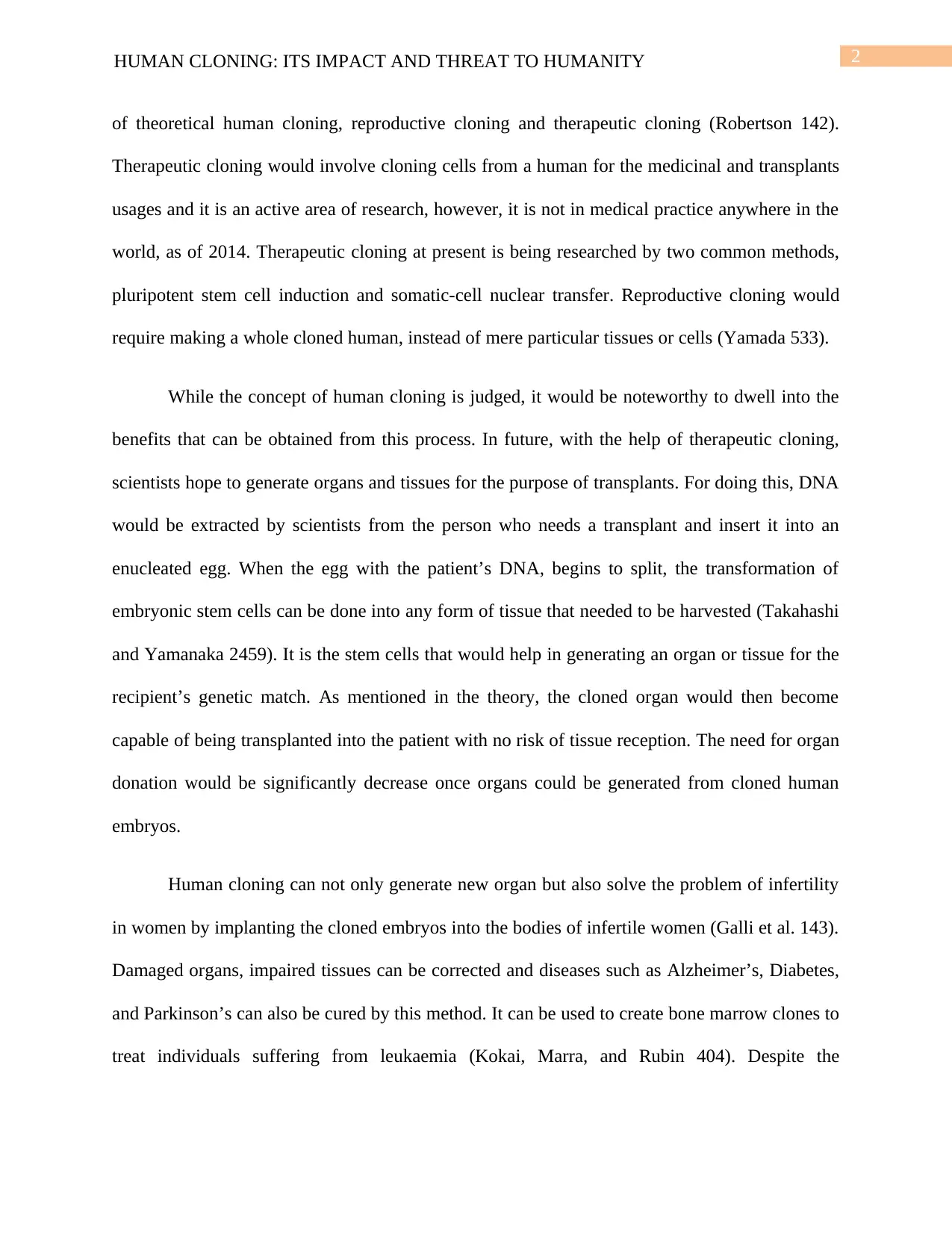
2HUMAN CLONING: ITS IMPACT AND THREAT TO HUMANITY
of theoretical human cloning, reproductive cloning and therapeutic cloning (Robertson 142).
Therapeutic cloning would involve cloning cells from a human for the medicinal and transplants
usages and it is an active area of research, however, it is not in medical practice anywhere in the
world, as of 2014. Therapeutic cloning at present is being researched by two common methods,
pluripotent stem cell induction and somatic-cell nuclear transfer. Reproductive cloning would
require making a whole cloned human, instead of mere particular tissues or cells (Yamada 533).
While the concept of human cloning is judged, it would be noteworthy to dwell into the
benefits that can be obtained from this process. In future, with the help of therapeutic cloning,
scientists hope to generate organs and tissues for the purpose of transplants. For doing this, DNA
would be extracted by scientists from the person who needs a transplant and insert it into an
enucleated egg. When the egg with the patient’s DNA, begins to split, the transformation of
embryonic stem cells can be done into any form of tissue that needed to be harvested (Takahashi
and Yamanaka 2459). It is the stem cells that would help in generating an organ or tissue for the
recipient’s genetic match. As mentioned in the theory, the cloned organ would then become
capable of being transplanted into the patient with no risk of tissue reception. The need for organ
donation would be significantly decrease once organs could be generated from cloned human
embryos.
Human cloning can not only generate new organ but also solve the problem of infertility
in women by implanting the cloned embryos into the bodies of infertile women (Galli et al. 143).
Damaged organs, impaired tissues can be corrected and diseases such as Alzheimer’s, Diabetes,
and Parkinson’s can also be cured by this method. It can be used to create bone marrow clones to
treat individuals suffering from leukaemia (Kokai, Marra, and Rubin 404). Despite the
of theoretical human cloning, reproductive cloning and therapeutic cloning (Robertson 142).
Therapeutic cloning would involve cloning cells from a human for the medicinal and transplants
usages and it is an active area of research, however, it is not in medical practice anywhere in the
world, as of 2014. Therapeutic cloning at present is being researched by two common methods,
pluripotent stem cell induction and somatic-cell nuclear transfer. Reproductive cloning would
require making a whole cloned human, instead of mere particular tissues or cells (Yamada 533).
While the concept of human cloning is judged, it would be noteworthy to dwell into the
benefits that can be obtained from this process. In future, with the help of therapeutic cloning,
scientists hope to generate organs and tissues for the purpose of transplants. For doing this, DNA
would be extracted by scientists from the person who needs a transplant and insert it into an
enucleated egg. When the egg with the patient’s DNA, begins to split, the transformation of
embryonic stem cells can be done into any form of tissue that needed to be harvested (Takahashi
and Yamanaka 2459). It is the stem cells that would help in generating an organ or tissue for the
recipient’s genetic match. As mentioned in the theory, the cloned organ would then become
capable of being transplanted into the patient with no risk of tissue reception. The need for organ
donation would be significantly decrease once organs could be generated from cloned human
embryos.
Human cloning can not only generate new organ but also solve the problem of infertility
in women by implanting the cloned embryos into the bodies of infertile women (Galli et al. 143).
Damaged organs, impaired tissues can be corrected and diseases such as Alzheimer’s, Diabetes,
and Parkinson’s can also be cured by this method. It can be used to create bone marrow clones to
treat individuals suffering from leukaemia (Kokai, Marra, and Rubin 404). Despite the
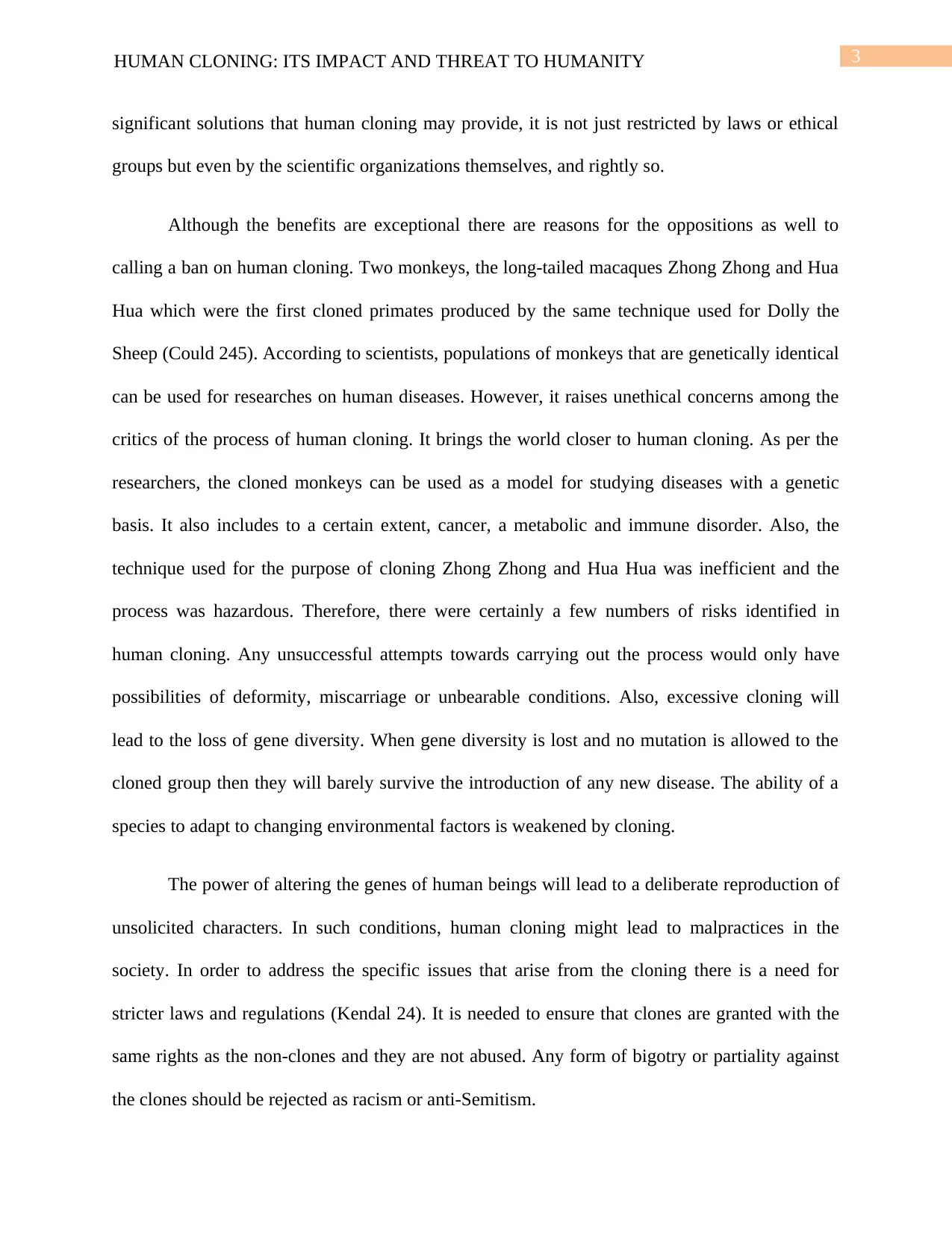
3HUMAN CLONING: ITS IMPACT AND THREAT TO HUMANITY
significant solutions that human cloning may provide, it is not just restricted by laws or ethical
groups but even by the scientific organizations themselves, and rightly so.
Although the benefits are exceptional there are reasons for the oppositions as well to
calling a ban on human cloning. Two monkeys, the long-tailed macaques Zhong Zhong and Hua
Hua which were the first cloned primates produced by the same technique used for Dolly the
Sheep (Could 245). According to scientists, populations of monkeys that are genetically identical
can be used for researches on human diseases. However, it raises unethical concerns among the
critics of the process of human cloning. It brings the world closer to human cloning. As per the
researchers, the cloned monkeys can be used as a model for studying diseases with a genetic
basis. It also includes to a certain extent, cancer, a metabolic and immune disorder. Also, the
technique used for the purpose of cloning Zhong Zhong and Hua Hua was inefficient and the
process was hazardous. Therefore, there were certainly a few numbers of risks identified in
human cloning. Any unsuccessful attempts towards carrying out the process would only have
possibilities of deformity, miscarriage or unbearable conditions. Also, excessive cloning will
lead to the loss of gene diversity. When gene diversity is lost and no mutation is allowed to the
cloned group then they will barely survive the introduction of any new disease. The ability of a
species to adapt to changing environmental factors is weakened by cloning.
The power of altering the genes of human beings will lead to a deliberate reproduction of
unsolicited characters. In such conditions, human cloning might lead to malpractices in the
society. In order to address the specific issues that arise from the cloning there is a need for
stricter laws and regulations (Kendal 24). It is needed to ensure that clones are granted with the
same rights as the non-clones and they are not abused. Any form of bigotry or partiality against
the clones should be rejected as racism or anti-Semitism.
significant solutions that human cloning may provide, it is not just restricted by laws or ethical
groups but even by the scientific organizations themselves, and rightly so.
Although the benefits are exceptional there are reasons for the oppositions as well to
calling a ban on human cloning. Two monkeys, the long-tailed macaques Zhong Zhong and Hua
Hua which were the first cloned primates produced by the same technique used for Dolly the
Sheep (Could 245). According to scientists, populations of monkeys that are genetically identical
can be used for researches on human diseases. However, it raises unethical concerns among the
critics of the process of human cloning. It brings the world closer to human cloning. As per the
researchers, the cloned monkeys can be used as a model for studying diseases with a genetic
basis. It also includes to a certain extent, cancer, a metabolic and immune disorder. Also, the
technique used for the purpose of cloning Zhong Zhong and Hua Hua was inefficient and the
process was hazardous. Therefore, there were certainly a few numbers of risks identified in
human cloning. Any unsuccessful attempts towards carrying out the process would only have
possibilities of deformity, miscarriage or unbearable conditions. Also, excessive cloning will
lead to the loss of gene diversity. When gene diversity is lost and no mutation is allowed to the
cloned group then they will barely survive the introduction of any new disease. The ability of a
species to adapt to changing environmental factors is weakened by cloning.
The power of altering the genes of human beings will lead to a deliberate reproduction of
unsolicited characters. In such conditions, human cloning might lead to malpractices in the
society. In order to address the specific issues that arise from the cloning there is a need for
stricter laws and regulations (Kendal 24). It is needed to ensure that clones are granted with the
same rights as the non-clones and they are not abused. Any form of bigotry or partiality against
the clones should be rejected as racism or anti-Semitism.
Secure Best Marks with AI Grader
Need help grading? Try our AI Grader for instant feedback on your assignments.
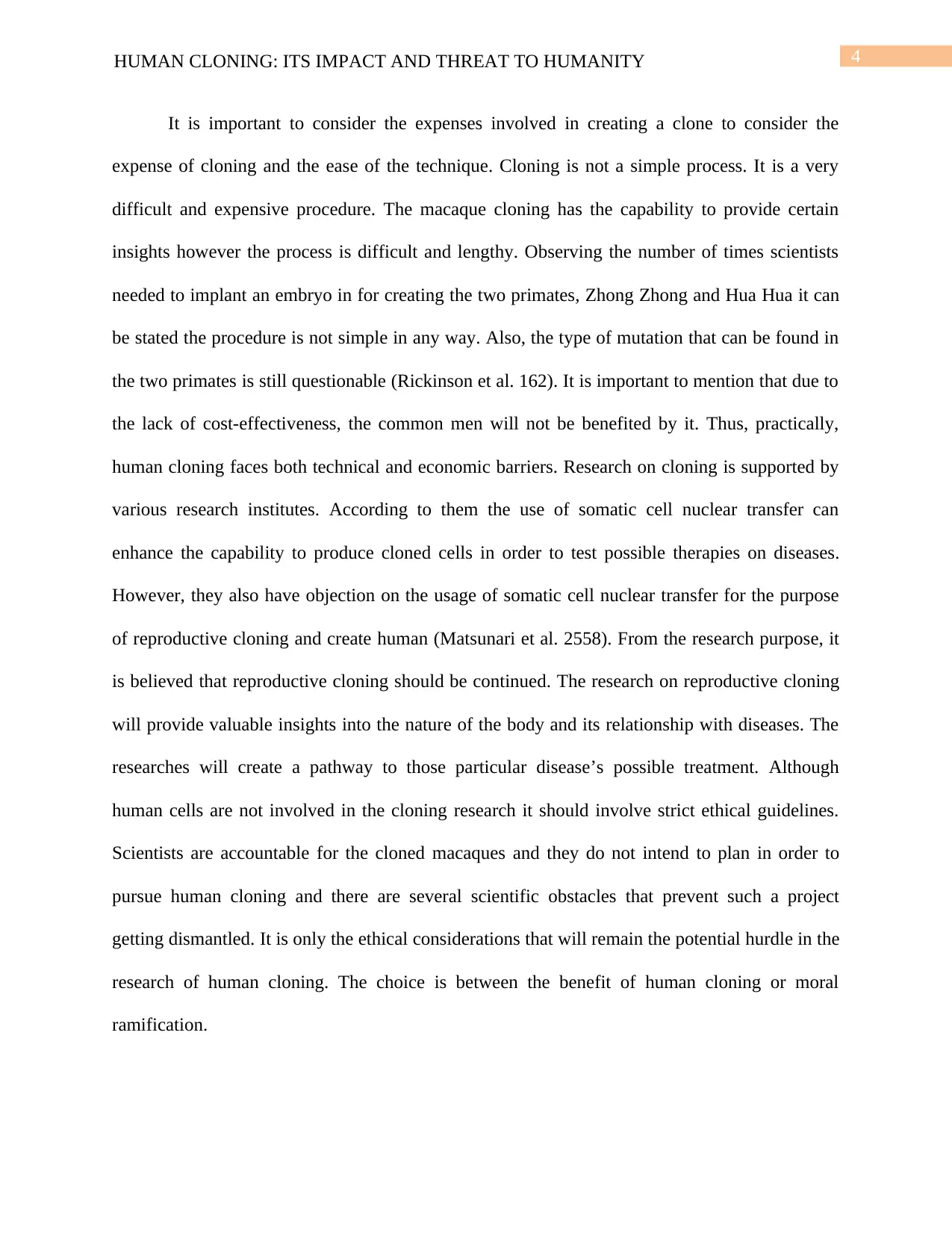
4HUMAN CLONING: ITS IMPACT AND THREAT TO HUMANITY
It is important to consider the expenses involved in creating a clone to consider the
expense of cloning and the ease of the technique. Cloning is not a simple process. It is a very
difficult and expensive procedure. The macaque cloning has the capability to provide certain
insights however the process is difficult and lengthy. Observing the number of times scientists
needed to implant an embryo in for creating the two primates, Zhong Zhong and Hua Hua it can
be stated the procedure is not simple in any way. Also, the type of mutation that can be found in
the two primates is still questionable (Rickinson et al. 162). It is important to mention that due to
the lack of cost-effectiveness, the common men will not be benefited by it. Thus, practically,
human cloning faces both technical and economic barriers. Research on cloning is supported by
various research institutes. According to them the use of somatic cell nuclear transfer can
enhance the capability to produce cloned cells in order to test possible therapies on diseases.
However, they also have objection on the usage of somatic cell nuclear transfer for the purpose
of reproductive cloning and create human (Matsunari et al. 2558). From the research purpose, it
is believed that reproductive cloning should be continued. The research on reproductive cloning
will provide valuable insights into the nature of the body and its relationship with diseases. The
researches will create a pathway to those particular disease’s possible treatment. Although
human cells are not involved in the cloning research it should involve strict ethical guidelines.
Scientists are accountable for the cloned macaques and they do not intend to plan in order to
pursue human cloning and there are several scientific obstacles that prevent such a project
getting dismantled. It is only the ethical considerations that will remain the potential hurdle in the
research of human cloning. The choice is between the benefit of human cloning or moral
ramification.
It is important to consider the expenses involved in creating a clone to consider the
expense of cloning and the ease of the technique. Cloning is not a simple process. It is a very
difficult and expensive procedure. The macaque cloning has the capability to provide certain
insights however the process is difficult and lengthy. Observing the number of times scientists
needed to implant an embryo in for creating the two primates, Zhong Zhong and Hua Hua it can
be stated the procedure is not simple in any way. Also, the type of mutation that can be found in
the two primates is still questionable (Rickinson et al. 162). It is important to mention that due to
the lack of cost-effectiveness, the common men will not be benefited by it. Thus, practically,
human cloning faces both technical and economic barriers. Research on cloning is supported by
various research institutes. According to them the use of somatic cell nuclear transfer can
enhance the capability to produce cloned cells in order to test possible therapies on diseases.
However, they also have objection on the usage of somatic cell nuclear transfer for the purpose
of reproductive cloning and create human (Matsunari et al. 2558). From the research purpose, it
is believed that reproductive cloning should be continued. The research on reproductive cloning
will provide valuable insights into the nature of the body and its relationship with diseases. The
researches will create a pathway to those particular disease’s possible treatment. Although
human cells are not involved in the cloning research it should involve strict ethical guidelines.
Scientists are accountable for the cloned macaques and they do not intend to plan in order to
pursue human cloning and there are several scientific obstacles that prevent such a project
getting dismantled. It is only the ethical considerations that will remain the potential hurdle in the
research of human cloning. The choice is between the benefit of human cloning or moral
ramification.
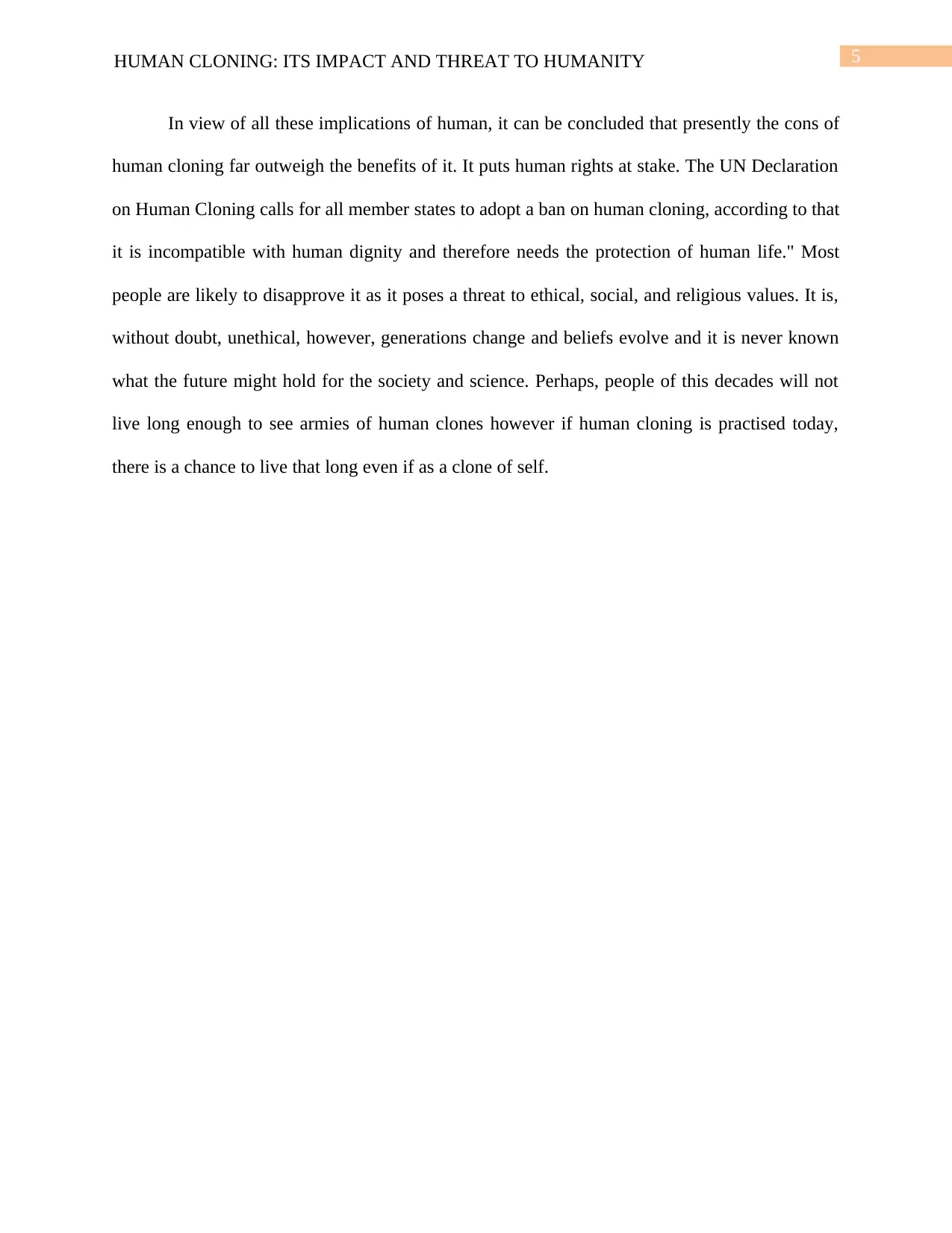
5HUMAN CLONING: ITS IMPACT AND THREAT TO HUMANITY
In view of all these implications of human, it can be concluded that presently the cons of
human cloning far outweigh the benefits of it. It puts human rights at stake. The UN Declaration
on Human Cloning calls for all member states to adopt a ban on human cloning, according to that
it is incompatible with human dignity and therefore needs the protection of human life." Most
people are likely to disapprove it as it poses a threat to ethical, social, and religious values. It is,
without doubt, unethical, however, generations change and beliefs evolve and it is never known
what the future might hold for the society and science. Perhaps, people of this decades will not
live long enough to see armies of human clones however if human cloning is practised today,
there is a chance to live that long even if as a clone of self.
In view of all these implications of human, it can be concluded that presently the cons of
human cloning far outweigh the benefits of it. It puts human rights at stake. The UN Declaration
on Human Cloning calls for all member states to adopt a ban on human cloning, according to that
it is incompatible with human dignity and therefore needs the protection of human life." Most
people are likely to disapprove it as it poses a threat to ethical, social, and religious values. It is,
without doubt, unethical, however, generations change and beliefs evolve and it is never known
what the future might hold for the society and science. Perhaps, people of this decades will not
live long enough to see armies of human clones however if human cloning is practised today,
there is a chance to live that long even if as a clone of self.
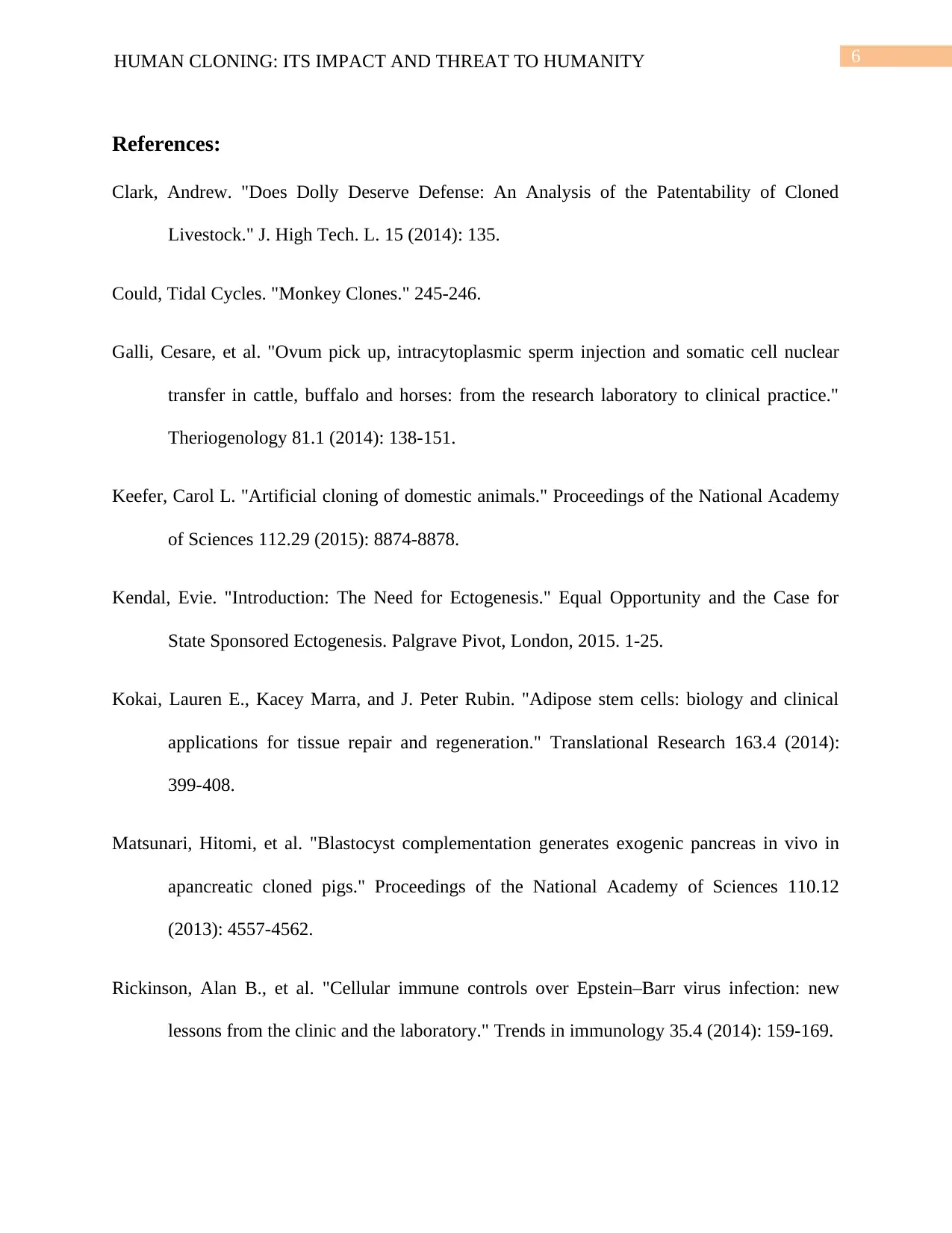
6HUMAN CLONING: ITS IMPACT AND THREAT TO HUMANITY
References:
Clark, Andrew. "Does Dolly Deserve Defense: An Analysis of the Patentability of Cloned
Livestock." J. High Tech. L. 15 (2014): 135.
Could, Tidal Cycles. "Monkey Clones." 245-246.
Galli, Cesare, et al. "Ovum pick up, intracytoplasmic sperm injection and somatic cell nuclear
transfer in cattle, buffalo and horses: from the research laboratory to clinical practice."
Theriogenology 81.1 (2014): 138-151.
Keefer, Carol L. "Artificial cloning of domestic animals." Proceedings of the National Academy
of Sciences 112.29 (2015): 8874-8878.
Kendal, Evie. "Introduction: The Need for Ectogenesis." Equal Opportunity and the Case for
State Sponsored Ectogenesis. Palgrave Pivot, London, 2015. 1-25.
Kokai, Lauren E., Kacey Marra, and J. Peter Rubin. "Adipose stem cells: biology and clinical
applications for tissue repair and regeneration." Translational Research 163.4 (2014):
399-408.
Matsunari, Hitomi, et al. "Blastocyst complementation generates exogenic pancreas in vivo in
apancreatic cloned pigs." Proceedings of the National Academy of Sciences 110.12
(2013): 4557-4562.
Rickinson, Alan B., et al. "Cellular immune controls over Epstein–Barr virus infection: new
lessons from the clinic and the laboratory." Trends in immunology 35.4 (2014): 159-169.
References:
Clark, Andrew. "Does Dolly Deserve Defense: An Analysis of the Patentability of Cloned
Livestock." J. High Tech. L. 15 (2014): 135.
Could, Tidal Cycles. "Monkey Clones." 245-246.
Galli, Cesare, et al. "Ovum pick up, intracytoplasmic sperm injection and somatic cell nuclear
transfer in cattle, buffalo and horses: from the research laboratory to clinical practice."
Theriogenology 81.1 (2014): 138-151.
Keefer, Carol L. "Artificial cloning of domestic animals." Proceedings of the National Academy
of Sciences 112.29 (2015): 8874-8878.
Kendal, Evie. "Introduction: The Need for Ectogenesis." Equal Opportunity and the Case for
State Sponsored Ectogenesis. Palgrave Pivot, London, 2015. 1-25.
Kokai, Lauren E., Kacey Marra, and J. Peter Rubin. "Adipose stem cells: biology and clinical
applications for tissue repair and regeneration." Translational Research 163.4 (2014):
399-408.
Matsunari, Hitomi, et al. "Blastocyst complementation generates exogenic pancreas in vivo in
apancreatic cloned pigs." Proceedings of the National Academy of Sciences 110.12
(2013): 4557-4562.
Rickinson, Alan B., et al. "Cellular immune controls over Epstein–Barr virus infection: new
lessons from the clinic and the laboratory." Trends in immunology 35.4 (2014): 159-169.
Paraphrase This Document
Need a fresh take? Get an instant paraphrase of this document with our AI Paraphraser
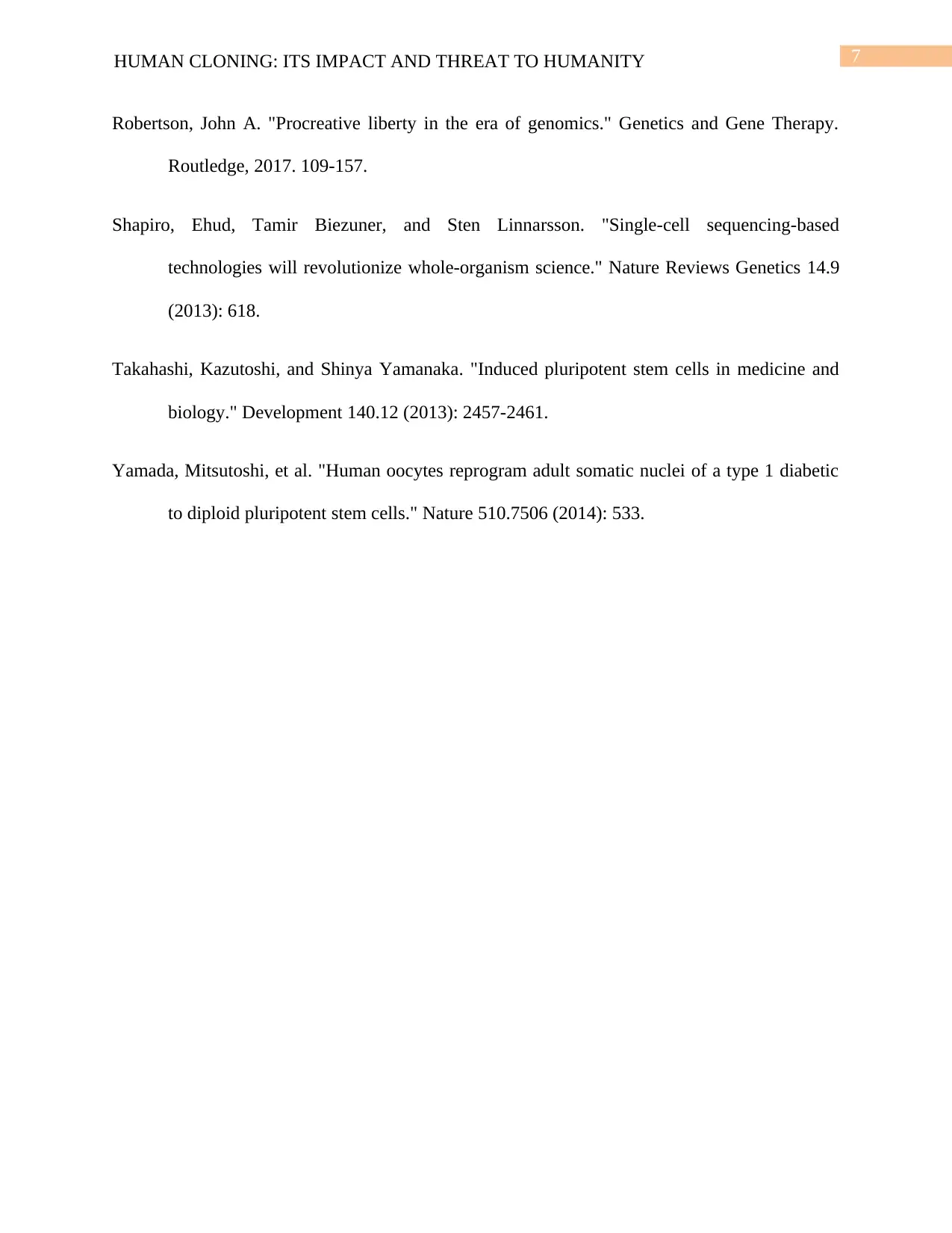
7HUMAN CLONING: ITS IMPACT AND THREAT TO HUMANITY
Robertson, John A. "Procreative liberty in the era of genomics." Genetics and Gene Therapy.
Routledge, 2017. 109-157.
Shapiro, Ehud, Tamir Biezuner, and Sten Linnarsson. "Single-cell sequencing-based
technologies will revolutionize whole-organism science." Nature Reviews Genetics 14.9
(2013): 618.
Takahashi, Kazutoshi, and Shinya Yamanaka. "Induced pluripotent stem cells in medicine and
biology." Development 140.12 (2013): 2457-2461.
Yamada, Mitsutoshi, et al. "Human oocytes reprogram adult somatic nuclei of a type 1 diabetic
to diploid pluripotent stem cells." Nature 510.7506 (2014): 533.
Robertson, John A. "Procreative liberty in the era of genomics." Genetics and Gene Therapy.
Routledge, 2017. 109-157.
Shapiro, Ehud, Tamir Biezuner, and Sten Linnarsson. "Single-cell sequencing-based
technologies will revolutionize whole-organism science." Nature Reviews Genetics 14.9
(2013): 618.
Takahashi, Kazutoshi, and Shinya Yamanaka. "Induced pluripotent stem cells in medicine and
biology." Development 140.12 (2013): 2457-2461.
Yamada, Mitsutoshi, et al. "Human oocytes reprogram adult somatic nuclei of a type 1 diabetic
to diploid pluripotent stem cells." Nature 510.7506 (2014): 533.
1 out of 8
Related Documents
Your All-in-One AI-Powered Toolkit for Academic Success.
+13062052269
info@desklib.com
Available 24*7 on WhatsApp / Email
![[object Object]](/_next/static/media/star-bottom.7253800d.svg)
Unlock your academic potential
© 2024 | Zucol Services PVT LTD | All rights reserved.





